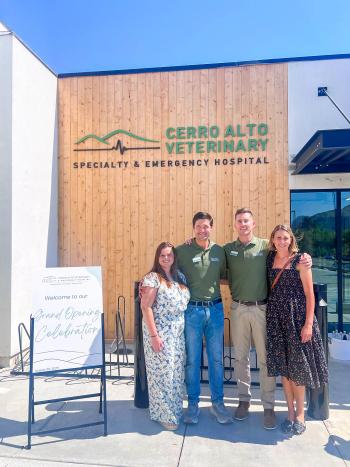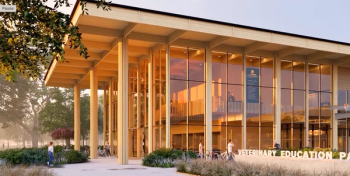
The evolution of client-friendly veterinary hospital design
In his final Hanging with Hafen column, Mark Hafen, AIA, reveals how hospital design has changed-and not changed-over the years.
Last month was the 25th annual Veterinary Economics Hospital Design Conference in Kansas City. Wow, 25 years. That's amazing!
“Building for client effectiveness” was my last seminar of the conference-and the last one I'll ever give as I'm stepping down from Animal Arts Design Studios as of the first of the year. But more about that later.
In truth, my last session was virtually the same one I gave when I first presented at the conference in 1989-except it was called, “Toward a friendlier building.” While the name and the times have changed a lot, the driving ideas have remained the same.
Join me on this journey through time as I show you how hospital design has changed-and not changed-over the years.
In the beginning ...
The first time I went to a hospital design conference I was an attendee. It was around 1987 and our firm had just landed our second veterinary hospital to design. Dr. Tom Sodowsky (the hospital owner) and I went down to New Orleans to learn how the heck to do it. The most memorable thing about the conference was when I emptied my pockets out onto the bed to count up what I had to live on for the next three days. Including the change and the paper money, my grand total was a couple of bucks. Right then and there I decided I had to stick tight to Tom! I thought if I could get him to buy me meals and beers, then maybe I would make it. Man, those were the days!
We also won our won our first Veterinary Economics Hospital Design Award around this time for a 3,300-square-foot facility in Louisville, Colo. It wasn't a big or fancy facility, but it represented a shift to a more client- and staff-friendly design.
Back then the radical new thing for veterinarians was advertising in the Yellow Pages. I can remember the first time I saw gigantic veterinary ads in the Boulder, Colo., section-it was a big deal! At that time, the Yellow Pages book for the Denver/Boulder metropolitan area was hundreds of pages and two volumes long. Today, I'm not sure if the Yellow Pages still exist.
Another innovation that represented a new era in veterinary hospital design? Pet food sales. This was the first time that veterinarians thought of themselves as a retail commodity. In fact, my 1989 Hospital Design Conference seminar, “Toward a Friendlier Building” was all about making your facility inviting to your clients and making it conducive to “selling” veterinary medicine.
The quintessential practice and facility with this retail focus was Dr. Steve Garner's Safari Pet Care Center in League City, Texas. Dr. Garner was hailed as a groundbreaker and was a frequent speaker at the veterinary conferences, primarily because he had the highest grossing hospital per-square-foot in the country. Safari Pet Care Center combined a relatively small leasehold veterinary facility with an equally sized pet shop that sold all kinds of pet products.
My simplest and most cost-effective idea at that time was for veterinarians to spend money on the doorknobs to their new hospitals. My reasoning was that this was the first and most memorable thing your client would encounter. The doorknob is like the satisfying “thunk” sound of a door closing on a well-made car. The sound and the feel of the door defined the first impression, and in turn the client experience. While a goofy idea, I would still maintain that your doorknob is the first and most critical component of your design.
The “client experience” is born
The '90s really were the age of expansion in terms of veterinary facilities. The veterinary industry exploded! As the veterinary market grew, it also became more sophisticated, clients were becoming more discerning, and veterinary facility design and the client experience were growing in importance. Starbucks arrived in the early part of the decade, marketing the whole client experience. This commodity that had previously been overlooked was very similar to what had been overlooked in the veterinary industry.
One example of a client-focused facility from the '90s is Animal Hospital of Howard (shown above) in Green Bay, Wis., complete with glass-fronted hall that let clients see into the medical areas of the hospital. Another was Polo Springs Veterinary Hospital (shown below) in Colorado Springs, Colo.-it featured a fireplace, greeter's desk and an upscale retail area.
But as quickly as veterinarians went “retail,” the market morphed again. The '90s saw attempts at consolidating the veterinary market. Dr. Scott Campbell effectively started the veterinary hospitals inside PetSmart in 1994 with VetSmart, and the Antin brothers started Veterinary Centers of America with their purchase of the West Los Angeles Animal Hospital. While most veterinarians perceived consolidation of the market as a significant threat, the impact was more subtle and pervasive than revolutionary.
Photos courtesy of Mark Hafen
More significantly, the emergence of large-scale veterinary specialty and referral centers also blossomed in the '90s. While most general practices had capped out at about 6,000 to 8,000 square feet, the smaller specialty hospitals started at 12,000 square feet and later grew to between 20,000 and 30,000 square feet.
The original Upstate Veterinary Specialists and Emergency Clinic was in this first generation of specialty hospitals and won the 2003 Veterinary Economics Hospital of the Year award. Several years later, the expanded Upstate facility (above) grew to be 24,000 square feet and represented the zenith of the trend toward client-friendly facilities. This project featured three glass-walled, sunlight-filled atriums, complete with stone fountains (see below).
Evidence-based design errupts
The early 2000s saw the beginning of evidence-based design. Founded in 2000, The Center for Health Design started gathering specific evidence that equated human hospital facility design with reducing stress for staff and patients and speeding up patient recovery. For the first time-thanks to the
Then came 2008 and everything froze as the economics readjusted.
Pet-friendly facilities take off
Now the industry is back on again. And we're beginning to see evidence-based design becoming part of veterinary facility design. And even more recently, patient-centered design has come to the forefront with Dr. Marty Becker's push toward
That brings us back around to the most recent Veterinary Economics Hospital Design Conference and my seminar, “Building for the client experience.” Granted this talk was packed with more than 90 pictures of beautiful client and patient-centered veterinary facilities, fundamentally it was the same as my, "Toward a Friendlier Building" seminar from approximately 25 years ago.
When you boil away all the other baloney, the theme and the intent were the same: designing veterinary facilities that are client-friendly and, in turn, patient-friendly pay off in terms of client satisfaction, staff effectiveness and patient health. That's what's important!
As I mentioned earlier, I'll be stepping down from Animal Arts Design Studios as of the first of the year so this will be my final Hanging With Hafen column. I look forward to my Animal Arts business partners-Heather Lewis, Tony Cochrane, Bryan King, Vicki Steppler and Ashley Shoults-carrying forward the client- and patient-friendly design I've campaigned for.
It's been a wonderful ride. I'll miss you.
-Mark
Newsletter
From exam room tips to practice management insights, get trusted veterinary news delivered straight to your inbox—subscribe to dvm360.






